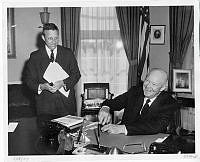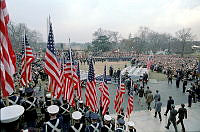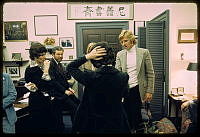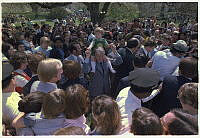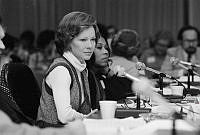Rubenstein Center Scholarship
Franklin D. Roosevelt's Train Ferdinand Magellan
Before U.S. Air Force One there was U.S. Train Car Number One, designed for the specifications of President Franklin D. Roosevelt and also used by three other presidents.
Presidential security was a priority during World War II. So was Roosevelt’s comfort. But the president did not make it easy on either count. If the security experts had their way, he would have spent much of the war ensconced in a bomb shelter underneath the White House East Wing, surrounded at all times by heavily armed troops and mountains of sandbags against the chance that German forces or agents launched an attack against him.
Roosevelt, however, insisted that security be maintained at minimally acceptable levels. He did so partly because he wanted to remain as much as possible in the public view, but also because tightly enclosed spaces made him claustrophobic. Roosevelt had been diagnosed in 1921 with poliomyelitis, which paralyzed him from the waist down. Although he tried to stay as active as possible, he had to spend much of his time confined to a wheelchair. As a result, he developed a fear of being trapped in spaces from which quick escape was physically impossible, especially in case of fire. He visited the completed White House bomb shelter only once, and never returned.

President Franklin D. Roosevelt on the observation deck of U.S. Car No. 1 in April 1943.
Franklin D. Roosevelt Presidential Library and Museum/NARAEventually Roosevelt was compelled to make some compromises. Security was a particular concern during his frequent travels, and his modes of transportation had to be adapted with that in mind. In the 1940s, many Americans including the president traveled frequently by train. Roosevelt was given a special car to enhance his safety and accommodate his physical needs.
In 1928, the Pullman Company built a fleet of six luxury train cars named after noted explorers. Roosevelt used one of them, the Marco Polo, during the first two terms of his presidency from 1933 to 1940. He also used the Roald Amundsen. By the time the United States entered World War II in late 1941, it had become apparent that the president needed far more than just plush accommodations for his long-distance trips around North America. As a result, one of the other trains, the Ferdinand Magellan, was refurbished for his wartime comfort and security. Presented to Roosevelt on December 18, 1942, it was dubbed U.S. Car No. 1 but operated under the code name POTUS.1
U.S. Car No. 1 was eighty-four feet long, ten feet wide and fifteen feet tall. The process of refurbishing nearly doubled its original weight to some 285,000 pounds, making it the heaviest railcar ever built in the United States and about triple the weight of a modern tank. It was encased in just over half an inch thick nickel-steel armor on all sides, along with bulletproof windows and—on Roosevelt’s insistence—two escape hatches through which aides could propel him if necessary.
The train car’s main cabin doubled as a dining and conference room. It enclosed a large mahogany table that could accommodate the president and seven guests. Behind this room were four bedrooms. The largest was of course intended for the president, and was fitted with his physical needs in mind. A washroom connected the president’s room to the first lady’s room, which was also amply appointed. The other two bedrooms were for the president’s guests. Behind them was an observation lounge. The rear platform featured hookups for microphones and speakers that the president could use for speeches at public events. Topping off all these arrangements, Roosevelt was given a special, narrow-framed wheelchair that allowed him to navigate the train car with ease.

President Harry Truman winks from the observation deck of the Ferdinand Magellan during his 1948 whistle stop tour.
Library of CongressRoosevelt traveled some 50,000 miles on U.S. Car No. 1 (the name Ferdinand Magellan was removed from the sides to make detection more difficult, although the car’s unique design made it stand out easily). The car was the last on the train, with a companion car, the Conneaut, just ahead. His guests on board during World War II included British Prime Minister Winston Churchill. The president also used the train to visit his home in Hyde Park, New York, and to carry out a grueling whistle stop tour during his re-election campaign in 1944. Security measures were always heightened during these trips, perhaps made more difficult by the president’s insistence on keeping the train at or below thirty miles per hour.
President Roosevelt died on April 12, 1945, at his home in Warm Springs, Georgia. The next day an eighteen-car train was assembled to carry the president’s body back to Washington, D.C. This time, however, U.S. Car No. 1 would not carry him, nor would it take its traditional place as the last car on the train. The president’s casket was too wide to fit through the heavily armored car’s doors, and the bulletproof windows could not be removed. Instead, the Conneaut carried Roosevelt’s body to Union Station, and from there to Hyde Park for burial.
President Harry Truman and his wife Bess accompanied Roosevelt’s body to Hyde Park, and the new president subsequently made U.S. Car No. 1 his own. He did not enjoy using the train as much as his predecessor. Truman ordered engineers to increase the train’s usual speed to eighty miles per hour, but still found the logistics of using the heavy car frustrating. Moreover, the security and of course the physical features intended to accommodate Roosevelt’s disability were no longer necessary.
Nevertheless, Truman used the train throughout his presidency, including during his 1948 whistle stop re-election campaign. The famous photo of Truman holding up a newspaper with the headline “Dewey Defeats Truman” was taken from the observation deck of the former Ferdinand Magellan. When his presidency ended in 1953, the car took Truman back to his hometown of Independence, Missouri after several thousand admirers serenaded him with a rendition of “Auld Lang Syne” as he stood on the observation deck at Washington, D.C.’s Union Station.2

President Ronald Reagan speaking on the telephone on board the Ferdinand Magellan during his train tour through Ohio on October 12, 1984.
Ronald Reagan Presidential Library and Museum/NARATruman’s successor, President Dwight D. Eisenhower, used U.S. Car No. 1 only occasionally. He preferred air travel. After the car’s apparently final official use in 1954 by First Lady Mamie Eisenhower, the government declared it surplus. The Gold Coast Railroad Museum of Miami, Florida, took charge of the car in 1959.3
But the Ferdinand Magellan’s official duties had not yet ended. In October 1984, President Ronald Reagan incorporated the car into his train “Heartland Special,” which he used to campaign along the same route that Truman had used in Ohio. “Nothing can stop us,” Reagan proclaimed from the observation deck, “because this train is bound for glory.” In 1985, the car was declared a National Historic Landmark.4








